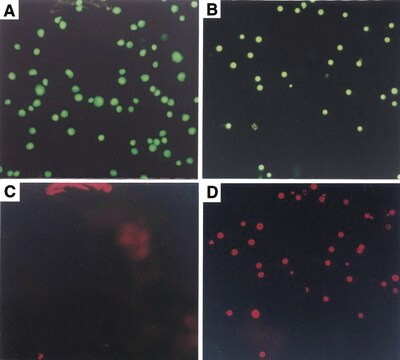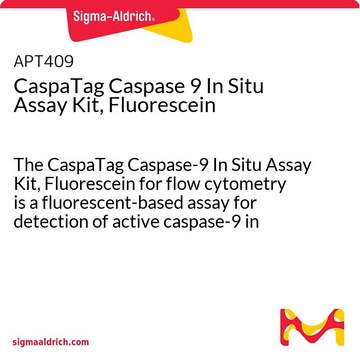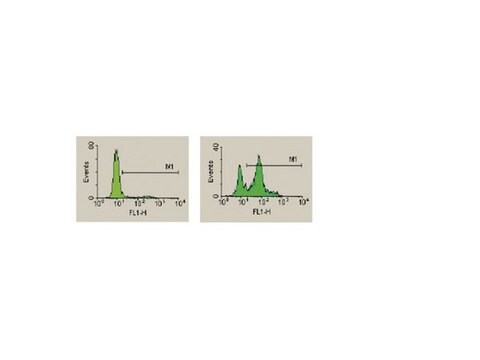APT408
CaspaTag Caspase 8 In Situ Assay Kit, Fluorescein
The CaspaTag Caspase-8 In Situ Assay Kit, Fluorescein for flow cytometry is a fluorescent-based assay for detection of active caspase-8 in cells undergoing apoptosis.
About This Item
Empfohlene Produkte
Qualitätsniveau
Hersteller/Markenname
CaspaTag
Chemicon®
Methode(n)
activity assay: suitable
flow cytometry: suitable
NCBI-Hinterlegungsnummer
UniProt-Hinterlegungsnummer
Nachweisverfahren
fluorometric
Versandbedingung
wet ice
Allgemeine Beschreibung
Caspases have been identified in organisms ranging from C. elegans to humans. The mammalian caspases play distinct roles in apoptosis and inflammation. In apoptosis, caspases are responsible for proteolytic cleavages that lead to cell disassembly (effector caspases), and are involved in upstream regulatory events (initiator caspases). An active caspase consists of two large and two small subunits that form two heterodimers, which associate in a tetramer2-4. In common with other proteases, caspases are synthesized as precursors that undergo proteolytic maturation, either autocatalytically or in a cascade by enzymes with similar specificity5.
Caspase enzymes specifically recognize a 4 or 5 amino acid sequence on the target substrate, which necessarily includes an aspartic acid residue. This residue is the target for cleavage, which occurs at the carbonyl end of the aspartic acid residue6. Caspases can be detected via immunoprecipitation, immunoblotting techniques using caspase specific antibodies, or by employing fluorochrome substrates, which become fluorescent upon cleavage by the caspase.
Anwendung
Apoptose & Krebs
Test Principle
CHEMICON′s CaspaTag Caspase-8 In Situ Assay Kits use a novel approach to detect active caspases. The methodology is based on Fluorochrome Inhibitors of Caspases (FLICA). The inhibitors are cell permeable and non-cytotoxic. Once inside the cell, the inhibitor binds covalently to the active caspase7. This kit uses a carboxyfluorescein-labeled fluoromethyl ketone peptide inhibitor of caspase-8 (FAM-LETD-FMK), which produces a green fluorescence. When added to a population of cells, the FAM-LETD-FMK probe enters each cell and covalently binds to a reactive cysteine residue that resides on the large subunit of the active caspase heterodimer, thereby inhibiting further enzymatic activity. The bound labeled reagent is retained within the cell, while any unbound reagent will diffuse out of the cell and is washed away. The green fluorescent signal is a direct measure of the amount of active caspase-8 present in the cell at the time the reagent was added. Cells that contain the bound labeled reagent can be analyzed by 96-well plate-based fluorometry, fluorescence microscopy, or flow cytometry.
Komponenten
10X Wash Buffer: 60 mL
Fixative: 6 mL
Propidium Iodide: 1 mL at 250 μg/mL, ready-to-use
Hoechst Stain: 1 mL at 200 μg/mL, ready-to-use
Lagerung und Haltbarkeit
· Reconstituted FLICA Reagent (150X) should be frozen at -20°C for up to 6 months, and may be thawed twice during this time. Aliquot into separate amber tubes if desired. Protect from light at all times.
· Store diluted (1X) wash buffer up to -20°C for 2 weeks.
Rechtliche Hinweise
Haftungsausschluss
Signalwort
Danger
Gefahreneinstufungen
Acute Tox. 3 Inhalation - Acute Tox. 4 Dermal - Acute Tox. 4 Oral - Carc. 1B - Eye Irrit. 2 - Muta. 2 - Skin Irrit. 2 - Skin Sens. 1 - STOT SE 2 - STOT SE 3
Zielorgane
Eyes,Central nervous system, Respiratory system
Lagerklassenschlüssel
6.1C - Combustible acute toxic Cat.3 / toxic compounds or compounds which causing chronic effects
Analysenzertifikate (COA)
Suchen Sie nach Analysenzertifikate (COA), indem Sie die Lot-/Chargennummer des Produkts eingeben. Lot- und Chargennummern sind auf dem Produktetikett hinter den Wörtern ‘Lot’ oder ‘Batch’ (Lot oder Charge) zu finden.
Besitzen Sie dieses Produkt bereits?
In der Dokumentenbibliothek finden Sie die Dokumentation zu den Produkten, die Sie kürzlich erworben haben.
Unser Team von Wissenschaftlern verfügt über Erfahrung in allen Forschungsbereichen einschließlich Life Science, Materialwissenschaften, chemischer Synthese, Chromatographie, Analytik und vielen mehr..
Setzen Sie sich mit dem technischen Dienst in Verbindung.










